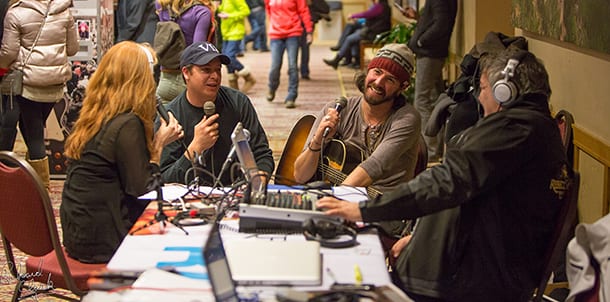By Jon Grossman
There’s something special about the radio. From FDR’s Fireside Chats and Orson Welles’ The War of the Worlds, to Alan Freed and Garrison Keillor, radio possesses an authenticity unlike any other medium. There’s magic in it too; with a turn of the dial, your fingertips transform static into sound, make meaning out of chaos. No matter how many millions fill the audience, you feel the DJ is talking just to you.
In recent history, a nemesis has emerged that threatens to pollute this precious resource… The forces of conformity and monochromatic taste have taken hold like never before. The dial turns, but the same sounds remain. Country music has responded to this ever-narrowing window with a spate of “bro-country” clichés, with song after song trudging out tired lines about driving back roads in pick up trucks while a girl in cut-off shorts puts her feet up on the dash.
Most people say they disagree with this trend, yet little seems to change. A recent study, The Same Old Song, found that radio consumers “indicate that they want more novelty when in fact their choices suggest that they do not.” People tell you they want to hear new music on the radio, but they prefer the more familiar song in a head-to-head comparison. The process remains mysterious, even to those involved in it.
As an aspiring artist myself, I am sincerely curious as to how these mechanics shake out. To help pull back the curtain, I spoke to songwriters, DJs, program directors and promoters to find out how different kinds of stations work, what it takes to get played, and what it takes to break a new artist.
Since broadcasting began a century ago, each step in its evolution ushered in unheard music, the mechanics of the industry influencing the content on the airwaves. Locally-operated Top 40 stations in the 1950s proved crucial to the dissemination of rock ‘n’ roll, while the growing popularity of FM in the late ’60s paralleled the emergence of prog-rock and album-oriented rock. Digital technology has likewise altered both the product and its placement, with the vast expansion of musicians mirrored in the plethora of online outlets. Alongside this diversity, a monolithic mass media has arisen, exemplified by a south Texas giant.
Although founded in 1972, San Antonio’s ClearChannel Communications truly came of age with the passage of the Telecommunications Act of 1996. Ostensibly aimed at lowering prices, the act proved instrumental in reducing the number of major media companies in this country, from around 50 in 1983 to only six in 2005. Taking advantage of the law’s easing of restrictions on owning multiple stations in the same market, the company grew to own 850 stations, with a weekly audience in excess of 100 million. Fairly or not, ClearChannel has become shorthand for media consolidation, and its stations, often with only a skeletal staff and a computer in charge of choosing songs, have become synonymous with everything wrong with the new media paradigm.
Janice Williams witnessed up-close the changes big media can bring. She joined Austin’s KVET in 2002, just after it was bought out by ClearChannel, and worked there as a DJ and later Music Director until 2007. The station began still committed to local artists, breaking Jason Boland and Kevin Fowler, among other early discoveries. Over time, that local emphasis dwindled as “operations became more and more like other corporate stations,” Williams said.
Sarah White, at Aggie96 in College Station, acknowledges that corporate dictums keep her from “being a snob with my playlist.” One formula – listeners per ad dollars – drives the bottom line and leads to a highly regulated on-air environment. “We play music that’s proven,” she said, “or stuff that’s carefully crafted to sell.” That means fewer opportunities to break new artists and little room in the hour for Texas country; the vast majority of her playlist is taken from recurrent classics and the two dozen songs at the top of current charts.
Other DJs maintain a place across the spectrum from homogenous. Buddy Logan started his Radio Texas, LIVE! show at Tyler’s KNUE in 2011, and despite its expansion into 14 markets across Texas, Oklahoma, Louisiana and South Dakota, he maintains a stubborn autonomy over his playlist. “99% of what I’ve played I’ve picked; no one’s gonna keep me from playing a good song. There are so many songs that need to be heard that aren’t,” he said. Some of his independence derives from a healthy ignorance about the nature of the industry, though he acknowledges that his freedom is “not typical” of today’s jocks. His enthusiasm for new music is infectious; during our recent conversation, he mused on Sturgill Simpson’s new album with an almost childlike wonder.
Angling for airplay influences musicians and can lead to a regimented environment aimed at chart success. Thom Shepherd plied his trade in Nashville for years and said, “When you write for a living, it’s always in the back of your mind that you want to keep your job.” The aim was to get your song cut by a mainstream artist, and along the way, many adventurous ideas were abandoned for being impractical. “When something sells, it’s follow the leader,” he said, noting that he loves Wade Bowen’s “Songs About Trucks” for reacting to that trend. Trying to sell doesn’t often make for great art; as Janice Williams opined, “I am appalled by what I hear out of Nashville today.”
Like Willie before him, Shepherd made the move from Nashville to Texas in part to reclaim his artistic freedom from the constraints of the bottom line. Radio promoter Clay Neuman likewise looked outside of Nashville at the turn of the century to help develop what became the Texas Music Chart. Beginning with Pat Green’s watershed “Carry On” (co-written by Walt Wilkins), Neuman acted as midwife for the birth of a distinct market in the state long before the rest of Nashville took note. He’s also decidedly optimistic about the state of radio. Pointing to Justin Frazell at Ft. Worth’s The Ranch as an exemplar, Neuman said, “Program directors have risen in the ranks because they can tell what’s real and what’s not.” No matter what other forces conspire, he maintains that “at the end of the day, fans determine” what’s a hit and what isn’t.
Austin-area audiences are blessed with a surfeit of options, with a number of stations distinguishing themselves for their independence, among them KOKE FM, KDRP in Dripping Springs, and KNBT in New Braunfels. This, along with a dizzying array of venues and live acts, create “quite possibly the most discerning and very likely the most intelligent audience in the country,” according to Matt Reilly, the Program Director at Austin’s KUTX. Reilly acknowledges that his audience, as with other public stations, will never rival the majors in size. “We’re a niche format,” he said. Yet with an adventurous set of DJs coupled with a pipeline into NPR, KUTX manages to break new artists consistently, with locals Shakey Graves and Max Frost being only recent examples. Reilly encourages listeners to try out the left side of the dial, wherever their locale, since “Arcade Fire, The Black Keys and Arctic Monkeys [or since many chart-topping bands] all got a ton of attention on public radio before commercial radio found them suitable for the masses.”
So what does it take to break on the radio these days? Like the Supreme Court’s definition of obscenity, we know it when we hear it. “It’s easier to disqualify a hit than to identify it,” said Williams, and other DJs were likewise tongue-tied to actually name the ineffable attributes that make for a hit song. For Clay Neuman, there are certain components that lead to radio play: “Has to be a good song, first and foremost, needs to be promoted by somebody with a track record for quality, and the band has to work!” Beyond the mere merits, there are the x factors. “People want to take ownership of something that’s real,” Neuman said, “and when a band’s on the rise, people are excited to hear about the rise.”
A hit often surprises its writer. Shepherd wrote off both of his biggest hits as too personal or too different, but despite writing them for himself alone, “Redneck Yacht Club” and “Private Malone” both went to number one. The right set of circumstances can propel someone new and different as well, evidenced by Kacey Musgrave’s decidedly un-cliché writing topping the charts and winning Grammys.
Many are the forces that seek to drown out new voices, yet somehow they continue to emerge. Despite the growing mechanization and de-humanization of the radio game, there still exists the capacity for the spark of inspiration to cast out over the horizon, and reach hungry ears wherever they wait. The tide of conformity always will rise, yet the mighty radio wave remains poised to topple it once more.


